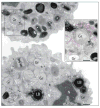Contributions of electron microscopy to understand secretion of immune mediators by human eosinophils
- PMID: 20875166
- PMCID: PMC3420811
- DOI: 10.1017/S1431927610093864
Contributions of electron microscopy to understand secretion of immune mediators by human eosinophils
Abstract
Mechanisms governing secretion of proteins underlie the biologic activities and functions of human eosinophils, leukocytes of the innate immune system, involved in allergic, inflammatory, and immunoregulatory responses. In response to varied stimuli, eosinophils are recruited from the circulation into inflammatory foci, where they modulate immune responses through the release of granule-derived products. Transmission electron microscopy (TEM) is the only technique that can clearly identify and distinguish between different modes of cell secretion. In this review, we highlight the advances in understanding mechanisms of eosinophil secretion, based on TEM findings, that have been made over the past years and that have provided unprecedented insights into the functional capabilities of these cells.
Figures




Similar articles
-
Piecemeal degranulation in human eosinophils: a distinct secretion mechanism underlying inflammatory responses.Histol Histopathol. 2010 Oct;25(10):1341-54. doi: 10.14670/HH-25.1341. Histol Histopathol. 2010. PMID: 20712018 Free PMC article. Review.
-
Vesicular trafficking of immune mediators in human eosinophils revealed by immunoelectron microscopy.Exp Cell Res. 2016 Oct 1;347(2):385-90. doi: 10.1016/j.yexcr.2016.08.016. Epub 2016 Aug 22. Exp Cell Res. 2016. PMID: 27562864 Free PMC article. Review.
-
Mechanisms of eosinophil secretion: large vesiculotubular carriers mediate transport and release of granule-derived cytokines and other proteins.J Leukoc Biol. 2008 Feb;83(2):229-36. doi: 10.1189/jlb.0707503. Epub 2007 Sep 17. J Leukoc Biol. 2008. PMID: 17875811 Free PMC article. Review.
-
Electron tomography and immunonanogold electron microscopy for investigating intracellular trafficking and secretion in human eosinophils.J Cell Mol Med. 2008 Aug;12(4):1416-9. doi: 10.1111/j.1582-4934.2008.00346.x. Epub 2008 Apr 9. J Cell Mol Med. 2008. PMID: 18410520 Free PMC article.
-
Vesicle-mediated secretion of human eosinophil granule-derived major basic protein.Lab Invest. 2009 Jul;89(7):769-81. doi: 10.1038/labinvest.2009.40. Epub 2009 Apr 27. Lab Invest. 2009. PMID: 19398958 Free PMC article.
Cited by
-
Eosinophil-derived cytokines in health and disease: unraveling novel mechanisms of selective secretion.Allergy. 2013 Mar;68(3):274-84. doi: 10.1111/all.12103. Epub 2013 Jan 25. Allergy. 2013. PMID: 23347072 Free PMC article. Review.
-
Pre-embedding immunogold labeling to optimize protein localization at subcellular compartments and membrane microdomains of leukocytes.Nat Protoc. 2014 Oct;9(10):2382-94. doi: 10.1038/nprot.2014.163. Epub 2014 Sep 11. Nat Protoc. 2014. PMID: 25211515 Free PMC article.
-
Eosinophil extracellular vesicles and DNA traps in allergic inflammation.Front Allergy. 2024 Aug 1;5:1448007. doi: 10.3389/falgy.2024.1448007. eCollection 2024. Front Allergy. 2024. PMID: 39148911 Free PMC article. Review.
-
Unraveling the complexity of lipid body organelles in human eosinophils.J Leukoc Biol. 2014 Nov;96(5):703-12. doi: 10.1189/jlb.3RU0214-110R. Epub 2014 Sep 10. J Leukoc Biol. 2014. PMID: 25210147 Free PMC article. Review.
-
Extracellular Microvesicle Production by Human Eosinophils Activated by "Inflammatory" Stimuli.Front Cell Dev Biol. 2016 Oct 27;4:117. doi: 10.3389/fcell.2016.00117. eCollection 2016. Front Cell Dev Biol. 2016. PMID: 27833910 Free PMC article.
References
-
- Adamko DJ, Odemuyiwa SO, Vethanayagam D, Moqbel R. The rise of the phoenix: The expanding role of the eosinophil in health and disease. Allergy. 2005;60(1):13–22. - PubMed
-
- Ahlstrom-Emanuelsson CA, Greiff L, Andersson M, Persson CG, Erjefalt JS. Eosinophil degranulation status in allergic rhinitis: Observations before and during seasonal allergen exposure. Eur Respir J. 2004;24(5):750–757. - PubMed
-
- Armengot M, Garin L, Carda C. Eosinophil degranulation patterns in nasal polyposis: An ultrastructural study. Am J Rhinol Allergy. 2009;23(5):466–470. - PubMed
Publication types
MeSH terms
Substances
Grants and funding
LinkOut - more resources
Full Text Sources
Miscellaneous

